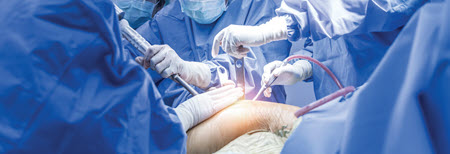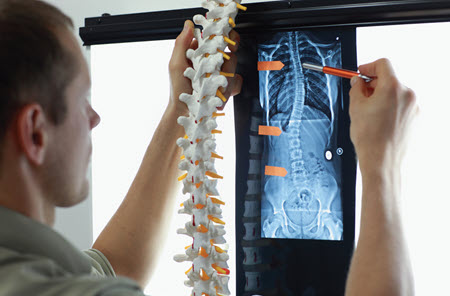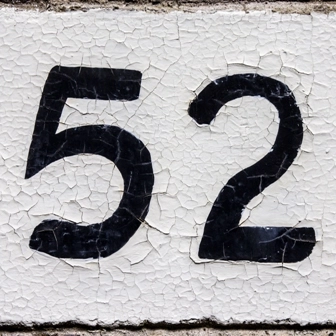Case Study Corner:
Can You Completely Code This Spinal Deformity Surgery Scenario?
Published on Thu Apr 06, 2023
Remember, there are anterior and posterior arthrodesis codes.
In last month’s issue of Neurosurgery Coding Alert, we talked about the skills and knowledge you’ll need to properly code arthrodesis for spinal deformity. This month, we’re going to put that training to use with a detailed case study.
The basics: We’ll run down all of the codes you’ll need to use for this quiz; every code you need will be in these lists. Then, we’ll present the case for you to code.

CPT® Primary Codes
Here are the primary CPT® codes you’ll be using for this case study:
- 22800 (Arthrodesis, posterior, for spinal deformity, with or without cast; up to 6 vertebral segments)
- 22802 (… 7 to 12 vertebral segments)
- 22804 (… 13 or more vertebral segments)
- 22808 (Arthrodesis, anterior, for spinal deformity, with or without cast; 2 to 3 vertebral segments)
- 22810 (… 4 to 7 vertebral segments)
- 22812 (… 8 or more vertebral segments)
CPT® Add-On Codes
Here are the CPT® add-on codes you’ll be using for this case study:
- +20930 (Allograft, morselized, or placement of osteopromotive material, for spine surgery only (List separately in addition to code for primary procedure))
- +22843 (Posterior segmental instrumentation (eg, pedicle fixation, dual rods with multiple hooks and sublaminar wires); 7 to 12 vertebral segments (List separately in addition to code for primary procedure))
- +22853 (Insertion of interbody biomechanical device(s) (eg, synthetic cage, mesh) with integral anterior instrumentation for device anchoring (eg, screws, flanges), when performed, to intervertebral disc space in conjunction with interbody arthrodesis, each interspace (List separately in addition to code for primary procedure))x6
- +61783 (Stereotactic computer-assisted (navigational) procedure; spinal (List separately in addition to code for primary procedure))
Modifier
The only modifier you’ll need for this case is 58 (Staged or related procedure…). The challenge is deciding where to use it.
ICD-10 Codes
The list of potential ICD-10 codes for the aforementioned arthrodesis surgical codes is long. Check with your payer, or consult your contract, if you have questions about whether a particular ICD-10 code proves medical necessity for 22800-22812.
With that said, here’s a list of potential ICD-10 codes you might see on a claim for arthrodesis for spinal deformity — and that you’ll choose from when coding the case.
- A18.01 (Tuberculosis of spine)
- C41.2 (Malignant neoplasm of vertebral column)
- E76.8 (Other disorders of glucosaminoglycan metabolism)
- G14 (Postpolio syndrome)
- M08.1 (Juvenile ankylosing spondylitis)
- M40.03 (Postural kyphosis, cervicothoracic region)
- M40.292 (Other kyphosis, cervical region)
- M40.45 (Postural lordosis, thoracolumbar region)
- M40.46 (Postural lordosis, lumbar region)
- M41.02 (Infantile idiopathic scoliosis, cervical region)
- M41.03 (Infantile idiopathic scoliosis, cervicothoracic region)
- M41.113 (Juvenile idiopathic scoliosis, cervicothoracic region)
- M41.122 (Adolescent idiopathic scoliosis, cervical region)
- M41.124 (Adolescent idiopathic scoliosis, thoracic region)
- M41.125 (Adolescent idiopathic scoliosis, thoracolumbar region)
- M41.34 (Thoracogenic scoliosis, thoracic region)
- M41.41 (Neuromuscular scoliosis, occipito-atlanto-axial region)
- M42.01 (Juvenile osteochondrosis of spine, occipito-atlanto-axial region)
- M42.02 (Juvenile osteochondrosis of spine, cervical region)
- M42.12 (Adult osteochondrosis of spine, cervical region)
- M42.13 (Adult osteochondrosis of spine, cervicothoracic region)
- M43.01 (Spondylolysis, occipito-atlanto-axial region)
- M43.9 (Deforming dorsopathy, unspecified)
- M43.11 (Spondylolisthesis, occipito-atlanto-axial region)
- M45.2 (Ankylosing spondylitis of cervical region)
- M47.811 (Spondylosis without myelopathy or radiculopathy, occipito-atlanto-axial region)
- M48.8X3 (Other specified spondylopathies, cervicothoracic region)
- M81.0 (Age-related osteoporosis without current pathological fracture)
- M88.1 (Osteitis deformans of vertebrae)
- M96.0 (Pseudarthrosis after fusion or arthrodesis)
- M96.5 (Postradiation scoliosis)
- Q67.5 (Congenital deformity of spine)
- Q76.2 (Congenital spondylolisthesis)
- Q76.3 (Congenital scoliosis due to congenital bony malformation)
- Q76.411 (Congenital kyphosis, occipito-atlanto-axial region)
- Q76.425 (Congenital lordosis, thoracolumbar region)
- Q76.426 (Congenital lordosis, lumbar region)
- Z98.1 (Arthrodesis status)
The case:
(Scenario and coding advice courtesy of Gregory Przybylski, MD, Chairman of Neuroscience at the New Jersey Neuroscience Institute, JFK University Medical Center in Edison, New Jersey.)
A 17-year-old female patient reports a progressive change in the shape of her back, causing back pain but no leg symptoms. She is also concerned about her body image, including a rib hump. She is neurologically intact; it is five years after menarche and the hump has not grown in the last year. Scoliosis imaging reveals a flexible thoracolumbar curve measuring 55 degrees to the right in the upper thoracic spine and a 35 degrees to the left curve in the lower thoracic/upper lumbar spine. An elective anterior and posterior staged deformity correction was recommended to correct the deformity.
In the first stage, a six-interspace anterior thoracic arthrodesis was performed with interbody cages at each interspace and cancellous allograft placement within the cages. After a recovery of several days, the surgeon performed a pre-planned posterior arthrodesis from T4-L3 with cancellous allograft and segmental posterior spinal instrumentation from T4-L3 using intraoperative navigation. This resulted in a substantial correction of her preoperative spinal deformity.
STOP:
Now, use the list of codes and encounter description to code the case. Remember, all the codes you’ll need are in the lists above the case.

The Coding:
First stage procedures: For the first stage of the surgery, report:
- 22810 for the arthrodesis
- +22853 (Insertion of interbody biomechanical device(s) (eg, synthetic cage, mesh) with integral anterior instrumentation for device anchoring (eg, screws, flanges), when performed, to intervertebral disc space in conjunction with interbody arthrodesis, each interspace (List separately in addition to code for primary procedure)) x 6 for the interbody cage insertions
- +20930 (Allograft, morselized, or placement of osteopromotive material, for spine surgery only (List separately in addition to code for primary procedure)) for the allograft
- M41.124 appended to 22810, +22853, and +20930 to represent the patient’s thoracic scoliosis
- M41.125 appended to 22810, +22853, and +20930 to represent the patient’s thoracolumbar scoliosis
Second stage procedures: For the second stage of the surgery, report:
- 22802 for the arthrodesis
- +22843 (Posterior segmental instrumentation (eg, pedicle fixation, dual rods with multiple hooks and
- sublaminar wires); 7 to 12 vertebral segments (List separately in addition to code for primary procedure)) for the segmental instrumentation
- +61783 (Stereotactic computer-assisted (navigational) procedure; spinal (List separately in addition to code for primary procedure)) for the intraoperative navigation
- +20930 for the allograft
- Modifier 58 (Staged or related procedure…) appended to 22802, +22843, +61783, and 20930 to show that the procedures were staged (planned and known about ahead of time)
- M41.124 appended to 22802, +22843, +61783, and +20930 to represent the patient’s thoracic scoliosis
- M41.125 appended to 22802, +22843, +61783, and +20930 to represent the patient’s thoracolumbar scoliosis`.






